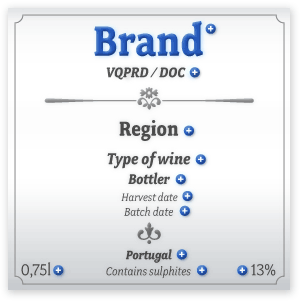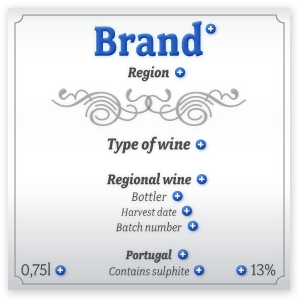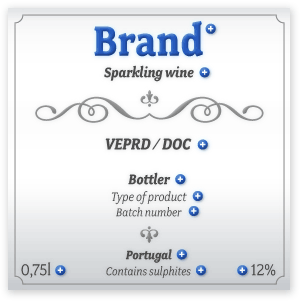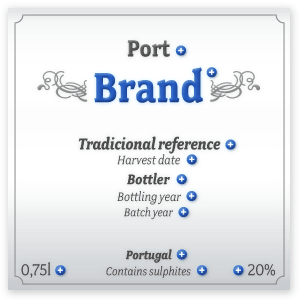In Portugal, the labels’ content is regulated and supervised by wine committees. The information contained in the label varies according to the type of wine. However, some elements are common to all labels, since the labelling rules derive from European Union legislation.




- Denomination of Controlled Origin
- Regional
- Sparkling
- Port

Brand
Commercial name for the wine.
VQPRD or DOC
Wine classification (Quality Wine Produced in a Specified Region / Denomination of Controlled Origin).
Region
Where the wine comes from.
Type of wine
Possible types are: white, rosé and red. Regarding sugar, the wine can be dry, semi-dry, semi-sweet or sweet.
Bottler
Who bottled the wine and where.
Harvest date
Year in which the grapes were harvested.
Batch number
Code used to identify the production number of a certain product packed under the same conditions.
Bottle capacity
Amount of wine in the bottle.
Portugal
The origin of the product. It has to be a product of Portugal.
Alcohol content
Litres of alcohol per 100 litres of wine.
Ingredientes
Presence of certain ingredients in wine, namely sulphites.

Brand
Commercial name for the wine.
Region
Geographical origin of the wine.
Type of wine
Possible types are: white, rosé and red. Regarding sugar, the wine can be dry, semi-dry, semi-sweet or sweet.
Regional Wine
Wine classification.
Bottler
Who bottled the wine and where.
Harvest date
Year in which the grapes were harvested.
Batch number
Code used to identify the production number of a certain product packed under the same conditions.
Alcohol content
Litres of alcohol per 100 litres of wine.
Portugal
The origin of the product. In this case, it has to be a product of Portugal.
Bottle capacity
Amount of wine in the bottle.
Ingredientes
Presence of certain ingredients in wine, namely sulphites.

Brand
Commercial name for the wine.
Sparkling Wine
Wine classification.
VEPRD or DOC
Certification that the wine has been produced in accordance with the rules of the producing region.
Bottler
Who bottled the wine and where.
Type of product
There are several varieties of white, rosé and red sparkling wines. Regarding sugar, sparkling wine can be natural brut, extra brut, brut, extra dry, dry, semi-sweet or sweet.
Bottle capacity
Amount of wine in the bottle.
Batch number
Code used to identify the production number of a certain product packed under the same conditions.
Portugal
The origin of the product. It has to be Portuguese.
Alcohol content
Litres of alcohol per 100 litres of wine.
Ingredientes
Presence of certain ingredients in wine, namely sulphites.

Port
Classification of the wine.
Brand
Commercial name for the wine.
Traditional reference
The traditional reference may be classified as: Vintage, LBV, Harvest date, Ruby, Tawny, White, among others.
Harvest year
The harvest year comes only in the Vintage, LBV and Colheita categories.
Bottler
Who bottled the wine and where.
Bottling Year
Present only in the following categories of Port: LBV, Harvest Date and Age Designation.
Bottle capacity
Amount of wine in the bottle.
Alcohol content
Litres of alcohol per 100 litres of wine.
Batch number
Code used to identify the production number of a certain product packed under the same conditions.
Portugal
The origin of the product. It has to be Portuguese.
Ingredientes
Presence of certain ingredients in wine, namely sulphites.


 How wine is made
How wine is made




